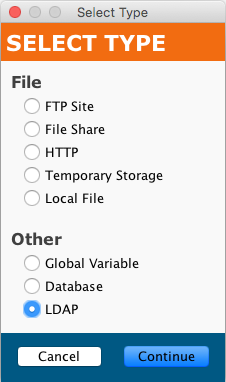Create an LDAP source in Jitterbit Design Studio
Introduction
This page describes how to create and configure an LDAP server as a source in Jitterbit Studio. For additional information see Using LDAP sources and targets.
Create an LDAP source
You can choose to create a new LDAP source on its own, or within an existing operation. For more information on how sources work within operations, see Creating an operation.
Create a new LDAP source as a standalone source
Within your project in Jitterbit Design Studio, you create a new LDAP source by any of:
-
Go to File > New > New Source; or
-
In the tree on the left, right-click on Sources and select New Source; or
-
In the top toolbar, click the green source icon
 .
.
In the popup, select LDAP as the type:

Your new source appears in its own New Source tab in the right pane of the window.
Note
If you create a standalone source using any of these methods, note that it is not connected to an operation. See Use an existing LDAP source in an existing operation below to use the new source.
Create a new LDAP source in an existing operation
A source is usually created by default when you create a new operation. (The exception is an operation that consists only of a script.) With an existing operation, you can specify the type of its source by:
-
Double-clicking on the source icon; in the popup, select Create New Source; or
-
Right-clicking on the source icon and selecting Create New Source.
In the configuration screen that appears, use the Type dropdown to select LDAP, as shown above.
Use an existing LDAP source in an existing operation
To use an existing LDAP source in an existing operation with a source, you can set it by any of:
-
Within the operation, double-clicking on the source icon, and in the resulting popup, selecting the desired LDAP source from the list; or
-
Within the operation, right-clicking on the source icon, choosing Select Existing Source, and in the resulting popup, selecting the desired LDAP source from the list; or
-
Dragging the desired LDAP source from the tree on the left and dropping it onto the existing source icon of the operation.
Configure an LDAP source
After you have created an LDAP source, the configuration screen will open in the main view of Design Studio. You can return to the configuration screen at any time by double-clicking on the source icon in the operation, or by double-clicking on the source in the tree on the left.
The configuration screen will appear similar to this example:
![]()
-
Name: Enter an appropriate, unique name for the source.
-
Type: Use the dropdown to select LDAP, if it is not already specified.
-
Connection Parameters: Specify the details for your LDAP connection:
-
Server: Enter the name of the LDAP server of the LDAP domain (required).
-
Login and Password: If applicable, enter a username and password that allows access to the LDAP server. Leave these fields blank if no username or password is required
-
Use default port: The default port is 389 for LDAP. For a different port, deselect the Use default port checkbox and enter a port to use in the Port field.
-
Base Distinguished Name: To access the LDAP source starting from a particular path, supply a Base Distinguished Name. This will be the starting point when querying the LDAP source for data when this source definition is used in an LDAP transformation.
-
Connection Mode: Choose an appropriate connection security mode, if required. When Secure connection is specified, the second checkbox for Enable SSL becomes available.
-
Test Connection: Clicking the
 button will test the LDAP source; it will fail if unable to make a connection to the LDAP server with the provided connection parameters.
button will test the LDAP source; it will fail if unable to make a connection to the LDAP server with the provided connection parameters. -
Click the Save button in either the main toolbar or the source's toolbar to save the configuration.
-
Tip
As of Harmony version 8.14.0, you can use global and project variables in LDAP sources and targets. They can be used to specify the server, login, password, and Base Distinguished Name used with the LDAP server.